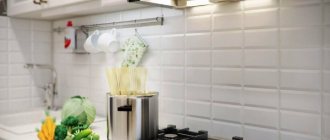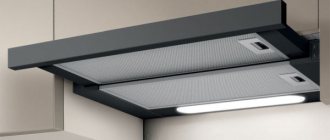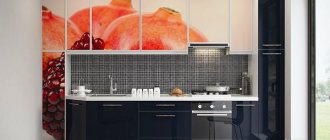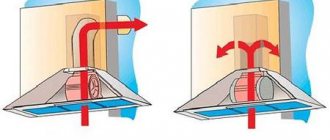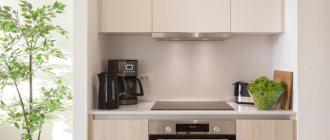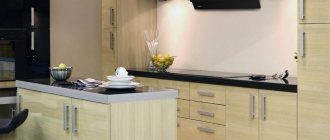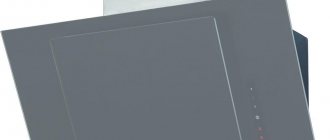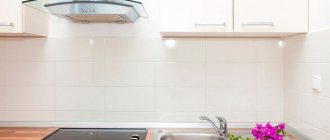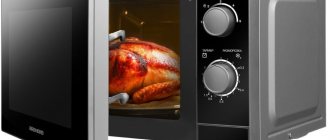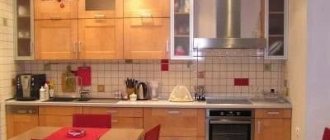To choose the right ventilation device, it is not enough to buy a high-quality and reliable hood. It is important that it has the required power. If it does not meet the necessary requirements, it will not be able to provide clean air in the room. During operation, a kitchen hood can only pass a certain volume of air through itself. It is necessary to calculate in advance what power it should have.
Types of kitchen hoods
Exhaust devices are divided into several types according to their method of operation, design and mounting option. The type of device often determines the degree of its performance, so at the first stage of selection, it is worth remembering this pattern.
- Flow-through hoods are models equipped with a dome that remove polluted air into the general ventilation system through the chimney. Such hoods can have quite high power.
- Recirculation hoods are compact hoods, the operating principle of which is to pass air masses through a system of cleaning filters. These models, as a rule, have less power than flow-through ones; they pass a limited volume of air through them.
The rules for calculating performance for different types of hoods are slightly different. In a recirculation system, the main factor is the power of the motor, and in a flow-through system, the efficiency of air removal into the ventilation shaft.
Recommended power
The power of kitchen hoods or their performance is an indicator of how effectively the device purifies the air in the room. This parameter is expressed in cubic meters of air mass passed through them in a fixed time. When determining it, they proceed from the current sanitary standards and SNiP requirements.
With the correct selection of a model with the required power, the cost of its purchase will be fully recouped over time due to the elimination of detergents and medicinal preparations. When calculating this indicator, it is important not to make a mistake in either direction. It is recommended to calculate the power of a kitchen hood, taking into account factors that actively influence its value.
Formula for calculating the performance of a recirculating hood
The standard calculation of the required performance of a kitchen hood is carried out using the following formula:
where: N - design capacity, m³/hour; S—kitchen area, m²; h – ceiling height, m; 12 - air exchange rate adopted by SES; 1.3—minimum reserve ratio.
Hood performance calculator
Kitchen area, m²: Ceiling height, m: Air exchange rate: Minimum reserve coefficient:
The universal formula allows you to calculate the parameters under the following assumptions:
- when using an electric stove;
- kitchen with closed doors and windows, separated from other rooms;
- The shape of the room is rectangular.
It is important to note that the calculation formula allows you to find out what volumes of air the device will process at maximum power and operating speed. Of course, in real conditions the device cannot constantly operate in the most energy-consuming mode. To obtain a more accurate result, it is recommended to add 15-20% to the final figure, this way you will calculate the performance of the kitchen hood for efficient operation in medium mode.
If a gas stove is used for cooking, then the coefficient of 12 should be changed to 20 without hesitation. In this case, in addition to fumes, ventilation will also have to remove gas combustion products from the kitchen. If the design has a carbon filter, it is worth adding 20 to 30%, since it creates additional resistance for the incoming air.
How to calculate the power and performance of a kitchen hood depending on the area of the room
The higher the exhaust power, the faster the air will be purified. The required productivity for a given room can be found in the table, where the calculations are based on the area of the kitchen and its height. The lowest productivity is for cheap models, approximately 200-300 m3/h. They can be installed only in small kitchens and provided that food is not cooked on the stove very often. If the hob is used frequently, then the power should be at least 600 m3/h.
We recommend reading: The use of peat - where and what peat is used for
- Save
Formula for calculating the power of a kitchen hood
You can do the calculations yourself using a simplified formula:
Q=S × H ×12
Q – exhaust power (m3/h);
S – kitchen area;
H – kitchen height;
12 – coefficient (number of air replacement cycles per hour)
- Save
According to sanitary standards, 10-15 air replacement cycles should occur within an hour. The factor 12 is the chosen average value.
For example, S= 10 m2, H=2.5 m2
With these values it turns out:
Q=10 × 2.5 × 12 = 300 m3/h.
Other factors to consider
Calculations using the formula have an average value, because other nuances must be taken into account:
- Hob type. For an electric stove, the coefficient reading can be up to 15, because apart from the fumes from the products, no other substances enter the air. But with a gas stove, harmful substances from gas combustion also enter the air. In this case, the coefficient is taken from 20.
- Hood type. When using flow-through, it is necessary to take into account the throughput of the existing ventilation shaft. With recirculation, this factor does not matter.
- Room layout. If there is an open entrance to the next room or the door there is often opened, then you need to take into account the large area of the room when calculating.
Calculation of the performance of a flow-through exhaust system
Calculation of the power of an exhaust hood with an air duct is also carried out by calculating the volume of air masses in the room. However, the performance of such a system is greatly influenced by the throughput of the duct. If the air exhaust duct is not installed correctly, the high-power appliance will not operate efficiently and may even fail. Frequent problems that arise are high noise levels and overheating of the electrical parts of the device.
In almost all apartment buildings, air ducts do not exceed 12–13 cm in diameter. Up to 400 m³ of air can be removed through them per hour. This figure should be taken into account when choosing a hood for the kitchen - if you buy a device with a higher performance, the power consumption will increase with a slight increase in productivity.
An important factor is the length and shape of the chimney pipe. If the exit to the ventilation shaft is too far from the installation site of the hood, and the channel itself has unevenness and angles, the air will pass through it at a lower speed. In this case, installing a powerful exhaust device is also unjustified.
Noise level at different device performance
noise level
When a large volume of air passes through the exhaust ducts, a sound naturally arises, which increases when the motor operates with high power. In residential areas, noise can interfere with the comfort of the kitchen and even penetrate into other rooms. Therefore, it is very important to choose a hood of such power that the noise level during its operation does not exceed permissible limits.
Small hoods with low power have the lowest noise levels - their values do not exceed 40–45 decibels. This is a fairly comfortable level for constant operation of the device in automatic mode. However, when choosing such a model, you will have to sacrifice the efficiency of its operation.
Kitchen hoods with high power have high noise levels and can create discomfort when working in small spaces. Experts recommend turning these devices “on full” only in emergencies; for daily use, set the settings to average. Then the hood will not make loud sounds during operation.
Factors affecting power calculation
To calculate the performance of a kitchen hood, the formula is used:
Q=s × h × 12.
Here, only the size of the room, height to the ceiling and air exchange rate are taken into account. This is a correct calculation, but not complete.
In addition to the kitchen area, the following parameters must be taken into account:
- family composition (clean air consumption must meet sanitary standards per person);
- frequency of cooking;
- what dishes are prepared (with fatty broth or healthy food);
- cross-section, length, material of air ducts.
Slab type
Undoubtedly, the area and type of stove affects the performance of the hood. The type of stove affects the amount of waste in the form of scale and burning that gets into the air when frying meat, boiling borscht, or healthy food with only vegetables. At the same time, the flow of fresh air into the room also occurs in different ways. Consequently, the air exchange rate also changes.
Let's take a closer look at how this happens:
- The calculation of a kitchen hood in the presence of an electric stove differs from the classic one, since combustion products do not penetrate into the air, except for steam from cooking food. As a rule, the air exchange rate for these electric stoves is increased in calculations from 12 to 15, while the classic formula will also change as follows:
Q=S × H × 15.
- When a gas stove is used, the air exchange rate increases to 20. This is due to the fact that in addition to evaporation, combustion products in the form of burning, soot, scorch, etc. enter the air space above the stove. Here the formula for calculating productivity will be different: S × H × 20.
- It would be incorrect to state unequivocally that if there is a cooking surface with an area of 65 cm, the hood should be more productive than with a smaller stove of 55 cm. However, logically this can be assumed, because larger hoods process the air mass from a stove of a larger surface. It is simply impossible to completely remove all harmful particles and odors from cooking at low power.
It is important not to make mistakes when calculating device parameters. Calculating the power of a hood is much easier if you take into account the main aspects.
Kitchen location
When calculating the performance of a kitchen hood, the type, area and isolation of it are taken into account. This could be: an apartment in the form of a studio, a kitchen and living room at the same time, a separate kitchen. Also, sometimes an arch is installed in the opening instead of a door, or the door is constantly open, in which case these parameters must also be taken into account.
Here the kitchen, one way or another, is combined with the adjacent room, so the conditions for calculating the performance of the hood increase several times. Thus, when calculating the power of the device, you need to take into account these additional parameters in the adjacent room, thereby fully providing your household with fresh air.
There is an opinion among users that in a small kitchen a low-power hood is sufficient. But in a small room, odors dissipate faster, which means there is a greater amount of polluted air.
Accordingly, in order for the air to be clean, air exchange must occur more often. However, a low-power hood simply will not be able to provide this, or the engine will overheat and sooner or later burn out.
Hob type
The type of stove determines how much pollutants can be released into the air during cooking. And updating it, accordingly, should occur more often or less often. The refresh rate must also be changed. The calculation of power for the kitchen when using an electric stove differs from the standard one, since no combustion products enter the air, except for fumes from the food being prepared. The coefficient for such slabs can be increased from 12 to 15, and the formula will look like this: Q=S*H*15.
Hood over electric stove
When you are going to use a gas hob, the coefficient should be increased to 20. This is done so that, in addition to fumes from the food being prepared, a large amount of harmful gas combustion products enters the atmosphere. In this case, the formula is written as: Q=S*H*20.
Hood over gas stove
What types of kitchen hoods are there?
Before proceeding to calculate the required power of the hood, you should decide on its type. There are several varieties of these household appliances. The difference between them is not only in design, but also in the principle of operation. This can be either the removal of polluted air from the room or its recirculation after appropriate cleaning.
Dome
The polluted air, after entering the dome of such an exhaust hood, is thrown out by fans outside through a piping system.
Features of dome-type exhaust devices:
- The system requires a minimum of maintenance, but during its operation it requires an influx of fresh air into the room from outside.
- If the kitchen has modern double-glazed windows that do not allow air to pass through, then you may need to open the window while the hood is operating.
- The disadvantages of this system also include quite significant dimensions and complex installation.
- Such hoods are recommended for use in spacious rooms.
- The complex of boxes and corrugated connections must have a minimum of bends that impede the movement of air.
Flat
These hoods are more compact and easy to install. Unlike dome ones, they do not require connection to ventilation ducts, as they work on the principle of air recirculation.
Features of flat hoods:
- They don't take up much space in the kitchen.
- Require regular maintenance: carbon filters responsible for neutralizing odors will have to be changed every 3-6 months, depending on the intensity of cooking.
- Soot and grease are captured by replaceable acrylic or permanent metal filters. The former will also have to be changed regularly, and the latter washed with detergents.
Built-in
It is better to buy built-in models at the stage of planning the overall kitchen interior. For them, you will have to select or specially order furniture in which most of the hood will be placed.
Features of built-in hoods:
- In their design, they are very similar to dome ones, but, as a rule, they are distinguished by greater power and lower noise levels.
- Most of their design will be hidden inside the furniture, so you won’t have to rack your brains about how to harmoniously fit such a hood into the overall composition of the kitchen.
Note! Even powerful dome and built-in hoods will not be able to provide more air exchange than the capacity of the apartment’s ventilation duct.
In most houses, ventilation ducts can provide unimpeded passage of no more than 180 m3 per hour. Therefore, it is preferable to use hoods that operate on the principle of air recirculation or mixed-type devices. Their higher cost is compensated by their independence from the ventilation capacity of the apartment. Also, there will be no need to solve the problem of fresh air entering the room.
Hood type
When choosing a hood, you need to understand how it differs from ventilation. According to regulatory requirements, every living space must be provided with fresh air.
This is achieved by equipping air inlets and outlets. They ensure that contaminated air exits through the exhaust pipe and fresh air enters. Ventilation is provided by natural air movement.
In most cases, its use is sufficient, but in this way it is impossible to remove steam, soot, and odors that form in the kitchen. An exhaust hood is used here to purify the air. It, unlike conventional ventilation, performs forced air purification. The hood collects all the polluted air and helps remove it outside. Before you calculate a kitchen hood, you need to decide on the type of device used.
Air purification using exhaust ventilation can be done in various ways. Some types of devices simply remove air to the outside. They are called flow-through. Others, recirculating ones, clean it and return it back.
There are combined types of devices that simultaneously use both methods of operation. Calculation of the hood's performance based on the kitchen area is carried out in accordance with sanitary standards.
Flow devices involve the use of large cross-section pipes. They can be round or square, or have a corrugated surface. Grease filters are located in the lower inlet part. They are designed to absorb grease and other airborne contaminants.
There are fans inside the structure that provide air movement. From the hood, air enters the ventilation system and is then discharged outside.
The recirculation hood is not connected to the ventilation system. The air inside it moves in a closed loop. This unit uses virtually no pipes. The fan extracts air and passes it through a special cleaning filter.
Such systems do not have bulky parts and look more aesthetically pleasing compared to flow-through devices. Filters used for coarse cleaning are made of aluminum. They can be cleaned using detergents.
Electrical energy is required to operate the hood, since air movement is ensured by constantly switched on fans. Usually they can operate in several modes. When turned on, it selects the one that best matches the intensity of work in the kitchen.
How to choose a kitchen hood based on power
External data and additional elements are not the main indicators. In the first place are technical data and volumes of purified air. The hood productivity is calculated in cubic meters/hour, and the power consumption is calculated in kilowatts spent on operating the device. In an hour, the equipment must refresh all the air in the room at least ten times.
The power of the hood depends on its performance. The more powerful the fan, the more air the hood will push through. Traditional power calculations are designed for circulation models. The productivity formula is simple.
You need to multiply the kitchen area by the ceiling height and by a factor of 12. If a gas stove is installed in the house, then the factor is changed to 20. The last figure is the sanitary standard for absorbed cubic meters of air in residential buildings. 20% of the power reserve is added to the finished value.
This formula will calculate ideal conditions for:
- kitchens with small electric stoves;
- closed premises;
- small rectangular room.
If there is an arched opening in the room or the door is always open, then calculations are made based on the area of the corridors.
Devices with an exhaust system require calculation of the air duct cross-section. In panel apartments, the cross-section of the ventilation ducts is 12.5 cm. This is enough to move about 400 cubic meters of air. A hood with a higher capacity will not cope with its task.
High-power equipment has a significant drawback: high noise levels. Most models are equipped with asynchronous electric motors, which are quieter than other household appliances. But if you turn on the hood at full power, the noise will cause discomfort. In a house where there are small children, it is better to install a quiet device. Inclined models have low noise levels and high power.
What affects the minimum required performance of the device?
When choosing an exhaust device with minimum performance, many factors are taken into account, such as the type of hob, the layout of the kitchen space and the location of the air duct.
Hob
To adjust the formula, depending on the type of hob, certain coefficients are used:
- For electric stoves the indicator is set to 1.5.
- When calculating the exhaust power for a gas surface, a coefficient of 2.0 is used. The indicator is due to the presence in the air of not only food vapors, but also gas combustion products.
Thus, the minimum equipment capacity for a kitchen of 12 m² and a ceiling height of 2.7 m with an electric stove is 486 m³/h, and with a gas stove - 648 m³/h. To comfortably use the device in medium performance modes, the kitchen hood should have a capacity in the range of 600-800 m³/h.
It should have dimensions equal to the dimensions of the hob. It is better to choose a device with large widths.
Exhaust system type
If the air ducts are connected to the ventilation duct of the apartment, natural air exchange can be disrupted. A hood placed above the stove will not be able to remove polluted air that accumulates near the ceiling.
When choosing a recirculation system, the performance of the device is of particular importance, because the air does not leave the kitchen, but returns to the room. The pressure of air masses increases when passing through filters, which reduces the performance of the device.
Each rotation of the ventilation duct reduces the system power by 10%. Taking into account the presence of filters in the recirculation system, 30% is added to the calculated capacity of the hood. Even considering the ease of installation of such a system, many apartment owners prefer the option with a tap.
Important! When connecting the hood to the air duct, add a power reserve factor of 1.3. If carbon filters are installed, it increases to 1.7.
When operating the device in exhaust mode, take into account the throughput of the air duct. You can increase the volume of pumped air by increasing the power, but the noise will increase and the electric motor will begin to overheat.
The standard ventilation duct has a diameter of 125 mm. 400 m³/h easily passes through it. In this case, a powerful hood will be ineffective. When calculating the power of equipment for a small kitchen in a simplified manner, you should pay attention to a low-power device. However, for a very small room (9 sq. m.) you will have to choose a model more powerful than the calculated one. This is due to the fact that small rooms are filled with odors faster.
Features of the kitchen layout
When choosing kitchen equipment, pay special attention to the area of the isolated room. It should be limited by doors, windows and walls. If the door to the kitchen does not close, or the room is combined with the living room, the indicators of the adjacent room are added to calculate the area. The result is a larger number, for example, 20 square meters. m.
Since cooking odors spread quickly, the performance requirements of a kitchen hood increase dramatically when multiple rooms are combined.
Dependence of noise level on performance
As power increases, the noise level of the operating system also increases. If it is too high, the person in the kitchen gets tired quickly, which leads to a deterioration in his condition and the quality of the food.
Modern equipment produces noise in the range of 40-45 dB. In household hoods, asynchronous motors are installed, which are much quieter than many vacuum cleaners and drills. However, the sound of the device begins to cause discomfort when the performance mode is increased.
The best option is to purchase a hood with adjustable power. It will not be possible to find a completely silent device, despite the efforts of the developers of modern climate control technology.
Important! To reduce operating noise of exhaust equipment, it is regularly serviced. Filters and air ducts require timely cleaning.
To remove odors from the kitchen, exhaust equipment with optimal power is selected. They take into account the area of the room, the type of stove, and the features of the ventilation system. It is important to consider the main factors so as not to buy a more powerful but ineffective device.
Calculation formula
The minimum calculation of kitchen hood power, depending only on the size of the area, is carried out using the formula Q=S*H*12. But it is recommended to use it only for small rooms. To prevent the device from constantly operating at maximum mode, it is recommended to add another 15% to the calculated value to reduce the load. There are calculators that help you calculate the power of your hood online.
The formula is adjusted depending on the type of plate. For electric surfaces, a coefficient of 1.5 is used, for gas surfaces - 2. When the exhaust system leads into the air duct, a coefficient of 1.3 is added - this is a power reserve. For recirculation models add 1.7.
Reference. The formula uses only one coefficient (maximum): either by the type of hob, or by the type of air purification.
An example of calculating the hood power for a kitchen with an area of 20 square meters. m
Let's look at how to calculate the hood power using the example of a kitchen with an area of 20 square meters. m with a ceiling height of 2.7 m. The room has an electric hob and an air vent. The coefficient for the electric stove is 1.5, for the ventilation system - 1.3. For the formula we take the maximum - 1.5.
Q=20*2.7*12*1.5=972. Thus, for this kitchen the hood capacity must be at least 972 m³/h.
Reference. The power rating of the equipment is indicated in the technical documentation or on a sticker on the case.
The most powerful kitchen hoods
Calculations of the optimal extraction power were given above. Now we present the top 5 most powerful models of 2021.
MAUNFELD URANIA 53
The UK company has developed one of the highest quality premium models that has many advantages over competitors' products. At the same time, it will not spoil the look of the kitchen, since it is completely built into it. Despite this, operating the device is very simple and does not cause any inconvenience.
Electronic control is organized using buttons and a display. In addition, you can switch the operating modes of the hood remotely, because it is equipped with a remote control.
As for power, in terms of this parameter Urania is considered one of the best. With a width of only 60 cm, it is capable of purifying up to 1250 cubic meters of air per hour.
It is also worth noting other advantages of the model: the presence of LED backlighting, a timer and four speed modes of operation. In addition, the new model received a perimeter suction system and an automatic ventilation function.
Kuppersberg F660
A fireplace-type kitchen hood, which, while not too expensive, boasts good performance. 900 cubic meters of purified air per hour puts it at a level above other competitors. Working with the model is very convenient. It has simple and intuitive touch controls that make it easy to adjust the operation of the device. You can adjust the hood to suit any conditions - it has five operating speeds.
Other advantages of the model are excellent design, low noise level during operation and the presence of a remote control. In addition, you can set a timer, thanks to which the device will turn on and off automatically.
Elica SPOT PLUS ISLAND IX/A/90
Quite a powerful hood, which at the same time has excellent functionality. The power of the model allows it to purify about 1200 cubic meters of air per hour. The device body is made in a minimalist style. The hood has a timer and an indicator showing the level of filter contamination. It is also worth noting the presence of an anti-return valve and pleasant lighting. Thanks to the presence of a small screen and touch panel, it is very easy to control the functions of the hood. Settings can be selected for a specific user.
It is important to pay attention to the presence of an intensive regime. It can be used to eliminate particularly strong odors that may arise when frying fish. When this option is enabled, the hood quickly purifies polluted air and then returns to standard operation.
Apart from the relatively high cost, it is difficult to note any other disadvantages of the hood. A high noise level is expected at such power.
Weissgauff Aura 1200 Remote BL
A powerful hood, in the development of which almost all modern technologies were used. It is capable of purifying 1200 cubic meters of air per hour. The model is completely built-in, so it will not take up much space in the kitchen and will fit into any design. Among the advantages, it is worth highlighting convenient touch controls and the presence of a remote control. In addition, the hood has the following advantages:
- perimeter suction system;
- efficiency – can work in very large rooms;
- digital display with large display;
- three speed modes and an automatic shutdown timer.
The hood can also operate in recirculation mode. To do this, you need to additionally purchase special carbon filters. The main disadvantage is the rather high noise level, but, as in the case of the previous model, this is due to its power.
Jetair Lilly 60 IX
A fireplace hood with a modern, pleasant design. It is suitable for a large kitchen, as it is capable of purifying up to 1200 cubic meters of air per hour.
In addition, the model has a large number of advantages: the presence of an anti-return valve and a filter contamination indicator, the ability to operate in drainage and recirculation modes. A convenient display and push-button controls allow you to work with the hood as comfortably as possible.
The model has three speed modes that can be configured for specific purposes. The main disadvantages are high noise levels and power consumption.
ELIKOR Onyx 60
The quiet inclined hood has an original appearance. The high level of performance allows you to absorb even the most pungent odors. It has four modes, the highest of which removes polluted air in a matter of minutes. The aluminum filter traps soot and grease. The workplace will be illuminated by two bright lamps. The touch buttons are protected by glass, which ensures flawless gear shifting. The noise level in turbo mode is 59 dB. The 15-minute timer absorbs residual odors after the hob has finished operating.
Faber GLASSY ISOLA/SP EG8 X/V A90
The most powerful island hood on the list. Completely eliminates combustion products, fat and soot. The built-in diffuser suppresses noise and ensures efficiency even with problematic ductwork. It is possible to install additional cleaning filters. The model provides 3 speed modes. The maximum noise level is 68 dB. The design allows the hood to fit harmoniously into any interior. Halogen lamps illuminate the hob. The glass surface can be used as a shelf for necessary things.
Design Tips
1. Do you want the main emphasis in the interior to be on facades and furniture? It would be more correct to choose a built-in kitchen cabinet for a hood or a wall-mounted direct hood. 2. Built-in invisible models and detailed dome designs are suitable for traditional-style interiors.
3. Modern kitchen style is characterized by clear and simple forms and laconic design. Built-in, wall and ceiling types of hoods without additional elements are suitable.
4. The color can be chosen to match the shade of the rest of the kitchen appliances (for example: chrome, white or black).
5. The choice of hood can also be influenced by the surface of your kitchen facades. Based on this, it can be glossy or matte.
